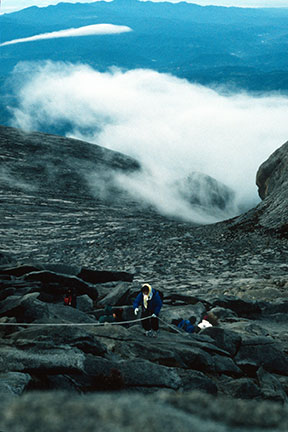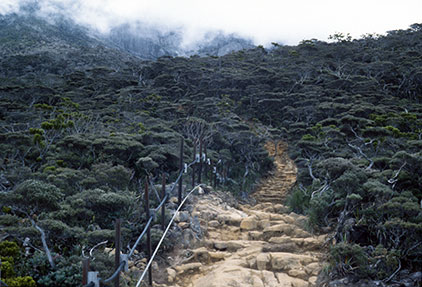BORNEO, MALAYSIA - This is unlike any other island I am familiar with, shared by three separate countries — Brunei, Indonesia and Malaysia as well as orangutans, proboscis monkeys, dwarf rhinos (which you will never see) and tribes of former head hunters. It is so far away from Peninsular Malaysia that your passport is rechecked upon arrival in Malaysian Borneo, as though you were arriving in a new land. And until recently, its highest mountain, Mount Kinabalu, was definitely unknown to most Canadian travellers.
Although I thought I knew this country, flying from continental Malaysia to Borneo convinced me I was wrong. The Malaysians I spoke to on the plane had never been to Borneo. None knew anyone who had been to the top of Mount Kinabalu, both Malaysia’s and South East Asia’s tallest mountain. Some spoke of strange traditions, like sleeping indoors with the lights on at the foot of the mountain. Others spoke of insects the size of small birds, and of insect-eating plants. To say I was intrigued would be a huge understatement.
When my wife and I finally make it to the top of sacred Mount Kinabalu, just after sunrise a few days later, and looked out over the distant jungles spread out far beneath us, we were proud of our accomplishment. Truth be told, we were also somewhat exhausted after two days of climbing.


Above: The mountain shines line a rare gem at sunrise but climbing it takes stamina.
One image that occurred at four in the morning predominates. Huffing and puffing in the dark, we stop to look up the mountain and see tiny lights an impossible distance away. Like minute fireflies in an otherwise black night, an army of fellow climbers seemed to beckon us to climb on. We were like a procession of monks, quietly making our way up to our rendezvous at the top of the mountain. Carole and I stopped to drink water and then, flashlight in one hand, and tightly grasping the rope in the other, we set off again.
Ascending Mount Kinabalu in the eastern part of Malaysian Borneo is a kind of experience that will remain vividly in your memory. And although no one calls me thunder thighs anymore, my quads are permanently enhanced thanks mainly to the brutal descent.
Visitors tackle the climb over two days, intending to get up in the wee hours of the morning, hoping to see the Bornean state of Sabah as part of a sunrise treat.
All climbers are required to hire a guide. He knows the way, will pace you, and for a small fee, will act as a porter. The guide became important as we climbed and critical as we descended.

Above: The vegetation along the trails is quite interesting.
The adventurer will want to climb Mount Kinabalu for many reasons. Its imposing form is visible from most parts of northern Sabah, Malaysia’s natural paradise. Its image is on the state flag. Furthermore, its slopes represent a botanist’s mecca and are the home to many animals — from praying mantises to leeches.
Our guide, Sapinus, had a good knowledge of the plant life, some of which is common on the mountain. On the path he pointed out balsam, rattan, jungle bananas, giant moss, wild begonias, rose berries and necklace orchids.
He mentioned there were thousands of different orchids in the park and over two dozen different kinds of rhododendron.
We encountered a wide range of plants, from jungle vegetation to the enchanted forest covered with Spanish moss and old man’s beard lichen. Two-thirds the way up, in an area called Sayat-Sayat in the local Dusan language, the land is covered with ancient trees displaying twisted limbs, a perfect spot to film a horror movie.
Near the end of the second afternoon, we arrive at Laban Rata Lodge to spend the night. Our tiny room with a simple heater is a refuge from the cold.
As arranged, we are awakened at 2:30 a.m. by our guide.
Continuing our ascent in the dark, we are concerned mainly with making the next step without slipping. We stopped to adjust coats, toques and gloves. It got cooler and cooler — the winds increased as we climbed. Some trekkers stop often, to catch their breath or numbed by the cold.
As morning broke we reached a strikingly bizarre plateau about 700 metres from the summit.
Behind, and below us, the port of Kota Kinabalu and the China Sea were visible in the distance. Sabah was visable for just a few minutes before the clouds rushed in to conceal the grand spectacle. Eventually, as we edged our way back down to Laban Rata Lodge for breakfast, we marvelled at the steep and tricky terrain we had negotiated in the pitch dark.
The walk down is far more difficult. We carefully make our way down, one step at a time. Just when our legs started to disobey our minds, our guide read my mind and asked, “Legs turning to jelly?”
Back at the park entrance we were presented with certificates. This was no simple self-esteem certificate from summer camp. We feel we have earned ours!
Information
For more information on this amazing part of the world, go to www.sabahparks.org.my/kp/ The best way to get to Malaysian Borneo is via Kuala Lumpur / From Kota Kinabalu, local buses run once a day to Ranau, passing the entrance to the Kinabalu Park headquarters on the way. The buses leave Kota Kinabalu at 7 a.m., reaching the Kinabalu Park HQ at 10 a.m. - a 88 kilometre journey. / The Park Headquarters can be found immediately to the right of the park entrance. Should you miss the Ranau bus, all buses running between Kota Kinabalu and Sandakan also go by the main entrance to the park.
About the Author
While still a teenager, Bruce Sach's travelling career started off badly. After being dragged by well-meaning parents onto a plane, he reluctantly took his seat only to have a flight attendant drop a bowl of salad on his head. He realized he should have stayed home. Years later, home (Edmonton) had shifted to Ottawa and he came to the conclusion that travel was an okay thing to do. Countless airplane meals and salad bowls later, Bruce is equally at ease in an Indonesian phinsi or viewing calving Greenlandic icebergs, and is able to adapt to most any locale. Every new destination increases his interest in visiting and reporting.